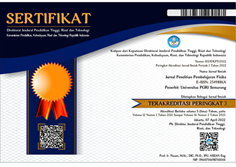Automated Disease Detection in Silkworms Using Machine Learning Techniques
DOI:
https://doi.org/10.26877/asset.v6i4.965Keywords:
Sericulture, Machine learning, Bombyx mori, Grasserie, HOGAbstract
Silkworm diseases pose a major threat to the sericulture industry, with early detection remaining a challenge due to limited infrastructure. This study focuses on detecting Grasserie disease, which can rapidly spread in silkworm rearing units, leading to significant economic losses. A novel dataset of 668 healthy and 574 Grasserie-affected silkworm images forms the basis of this research. The study applies machine learning techniques, using the Histogram Oriented Gradient (HOG) feature descriptor combined with Kernel Principal Component Analysis (KPCA) and supervised classifiers. The integration of Support Vector Machines (SVM) with HOG and KPCA achieved high accuracy (93.16%), recall (93.38%), and precision (91.94%), offering a faster, more accurate alternative to manual detection methods. This approach holds great potential for developing real-time, IoT-based diagnostic tools that enable farmers to quickly identify infected silkworms, reducing disease spread and economic losses, and can be extended to other agricultural applications requiring early disease detection.
References
M. Hăbeanu, A. Gheorghe, and T. Mihalcea, “Silkworm Bombyx mori—Sustainability and Economic Opportunity, Particularly for Romania,” Agriculture, vol. 13, no. 6, pp. 1209, 2023.
P. S. Chauhan and M. K. Tayal, “Mulberry Sericulture,” Industrial Entomology, pp. 197-263, 2017.
P. Makwana, H. Dubey, A. N. R. Pradeep, V. Sivaprasad, K. M. Ponnuvel, and R. K. Mishra, “Dipteran Endoparasitoid Infestation Actively Suppressed Host Defense Components in Hemocytes of Silkworm Bombyx mori for Successful Parasitism,” Animal Gene, vol. 22, pp. 200118, 2021.
S. Thomas and J. Thomas, “A Review on Existing Methods and Classification Algorithms Used for Sex Determination of Silkworm in Sericulture,” Proc. of International Conf on Intelligent Systems Design and Applications, Cham: Springer International Publishing, 2020, pp. 567-579.
M. M. I. Al-Ghiffary, C. A. Sari, E. H. Rachmawanto, N. M. Yacoob, N. R. D. Cahyo, and R. R. Ali, “Milkfish Freshness Classification Using Convolutional Neural Networks Based on Resnet50 Architecture,” Advance Sustainable Science Engineering and Technology, vol. 5, no. 3, p. 0230304, 2023
Y. Zhen, X. Dingyuan, T. Liang, and S. Meining, “Attention-Concatenation Dense Convolutional Neural Network for Silkworm Disease Recognition,” in 2020 5th International Conference on Smart Grid and Electrical Automation (ICSGEA), 2020, pp. 254-259.
V. Sivaprasad, R. K. Rahul, and P. Makwana, “Immunodiagnosis of Silkworm Diseases,”
Methods in Microbiology, vol. 49, pp. 27-46, Academic Press, 2021.
M. U. D. A. S. I. R. Gani, S. Chouhan, R. K. Babulal-Gupta, G. U. L. A. B. Khan, N. B. Kumar,
S. Pawan, and M. K. Ghosh, “Bombyx mori Nucleopolyhedrovirus (BmBPV): Its Impact on Silkworm Rearing and Management Strategies,” J. Biol. Control, vol. 31, no. 4, pp. 189-193, 2017.
M. Salva Afifi and S Salim Dahda, " Analysis of Improving the Quality of Fatty Acid Methyl Ester (FAME) Products Against Acid Value (AV) Levels Using the Six Sigma and Kaizen Methods", Advance Sustainable Science, Engineering and Technology, vol.6, no.2, pp 1-9, 2024.
A. Sharma, P. Sharma, J. Thakur, S. Murali, and K. Bali, “Viral Diseases of Mulberry Silkworm,
Bombyx mori L.—A Review,” J Pharmacogn Phytochem, vol. 9, no. 2S, pp. 415-423, 2020.
K. M. Babu, “Silk: Processing, Properties and Applications,” Woodhead Publishing, 2018.
K. M. Smith, “Insect Virology,” Elsevier, 2012.
S. Das, A. Bhattacharya, N. Debnath, A. Datta, and A. Goswami, “Nanoparticle-Induced Morphological Transition of Bombyx mori Nucleopolyhedrovirus: A Novel Method to Treat Silkworm Grasserie Disease,” Appl. Microbiol. Biotechnol., vol. 97, pp. 6019-6030, 2013.
C. Somu, R. Paulchamy, S. M. Moorthy, and J. Sundaram, “Antiviral Activity of Selected Medicinal Plants and Marine Seaweeds on the Grasserie Infected Larvae of Silkworm, Bombyx mori,” Arch. Phytopathol. Pflanzenschutz, vol. 50, no. 17-18, pp. 850-867, 2017.
I. P. Kamila, C. A. Sari, E. H. Rachmawanto, and N. R. D. Cahyo, “A Good Evaluation Based on Confusion Matrix for Lung Diseases Classification using Convolutional Neural Networks,” Advance Sustainable Science, Engineering and Technology, vol. 6, no. 1, p. 0240102, 2023.
S. Thomas and J. Thomas, “Nondestructive and Cost-effective Silkworm, Bombyx mori (Lepidoptera: Bombycidae) Cocoon Sex Classification Using Machine Learning,” Int. J. Trop. Insect Sci, pp. 1-13, 2024.
Santosa AP, Reesa M, Mawaddah L, Akrom M. Harnessing Quantum SVR on Quantum Turing Machine for Drug Compounds Corrosion Inhibitors Analysis. Advance Sustainable Science Engineering and Technology. vol. 6, no. 3, pp. 02403013, 2024.
S. Thomas and J. Thomas, “An Optimized Method for Mulberry Silkworm, Bombyx mori (Bombycidae: Lepidoptera) Sex Classification Using TLBPSGA-RFEXGBoost,” Bio Open, p. bio-060468, Jun. 2024.
V. A. Binson, M. Subramoniam, and L. Mathew, “Detection of COPD and Lung Cancer with Electronic Nose Using Ensemble Learning Methods,” Clin. Chim. Acta, vol. 523, pp. 231-238, 2021.
S. Thomas and J. Thomas, “Non-destructive Silkworm Pupa Gender Classification with X-ray
Images Using Ensemble Learning,” Artif. Intell. Agric., vol. 6, pp. 100-110, 2022.
S MNagashetti, B Sharanagouda, D D Srinidhi, C. G. Raghavendra, and B. D. Parameshachari. "Detection of disease in Bombyx mori silkworm by using image analysis approach." In 2021 IEEE Mysore Sub Section International Conference (MysuruCon), 2021, pp. 440-444.
D Xia, Y Zhen, C Anjun, T Liang, and S Meining. "Development and application of silkworm disease recognition system based on mobile App." In Image and Graphics: 10th International Conference, ICIG 2019, Beijing, China, August 23–25, 2019, Proceedings, Part II 10, pp. 471-
Springer International Publishing, 2019.











